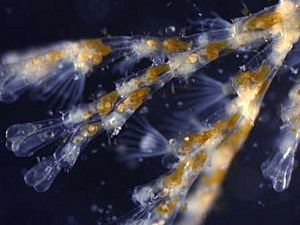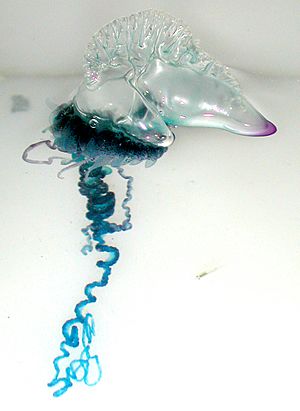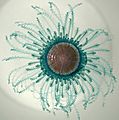Hydrozoa
The Hydrozoa are a group of small animals that mostly live in the ocean. They are part of a larger group called Cnidaria, which also includes jellyfish and coral. Most hydrozoans are tiny predators.
The basic shape of a hydrozoan is a polyp. Think of a small tube with a mouth at one end, surrounded by tentacles. Some hydrozoans live alone, while others live together in large groups called colonies. These colonies can look very different from single polyps!
Contents
Meet the Hydra
One of the most famous freshwater hydrozoans is called Hydra. You can find Hydra in calm, slow-moving water.
Hydra stays in one place, attached to things like rocks or plants with a special sticky foot called a pedal disc. Like all animals in the Cnidaria group, Hydra uses special stinging cells called nematocysts. These cells help them catch their food. Hydra eats small creatures like tiny shrimp, insect larvae, and worms.
How Hydra Reproduces
Hydra can make new Hydra in two ways:
- Sexual reproduction: This involves male and female cells coming together.
- Asexual reproduction: This is often called "budding." A small bump, or bud, grows on the side of the parent Hydra. This bud then grows into a new, complete Hydra and eventually breaks off.
Amazing Colonial Hydrozoans
Some hydrozoans live in colonies, where many tiny individuals work together like one big animal.
The Portuguese Man o' War
The Portuguese Man o' War (Physalia physalis) is a large colonial animal that floats in the ocean. It looks like a single jellyfish, but it's actually made up of many tiny, specialized individuals called zooids. Each zooid has a specific job, like catching food, reproducing, or stinging.
This colony has a gas-filled float that helps it stay on the surface of the water. The Portuguese Man o' War has very long, powerful stinging tentacles that can deliver a strong sting to its prey. If a human gets stung, it can be very painful and sometimes requires medical help. Interestingly, some fish can live safely among its tentacles because they are immune to the stings! These types of hydrozoans are called siphonophores.
Other Floating Colonies
Another type of colonial hydrozoan that floats in the open ocean is called a chondrophore. These animals also eat other creatures, but their sting is usually not as harmful to humans as the Portuguese Man o' War's.
Freshwater Jellyfish Life Cycle
Not all jellyfish live in the ocean! There are also freshwater jellyfish. These jellyfish have a special muscular flap called a velum on their underside. This velum helps them move around in the water.
Reproduction and Life Cycle
Freshwater jellyfish start their lives as tiny polyps, which attach themselves to plants. During spring and summer, these polyps feed and can reproduce sexually, creating new jellyfish. If there's only one sex of jellyfish in an area, they can also reproduce by budding, just like Hydra. When winter comes, they form special resting bodies to survive the cold until spring.
Images for kids
See also
 In Spanish: Hidrozoos para niños
In Spanish: Hidrozoos para niños








